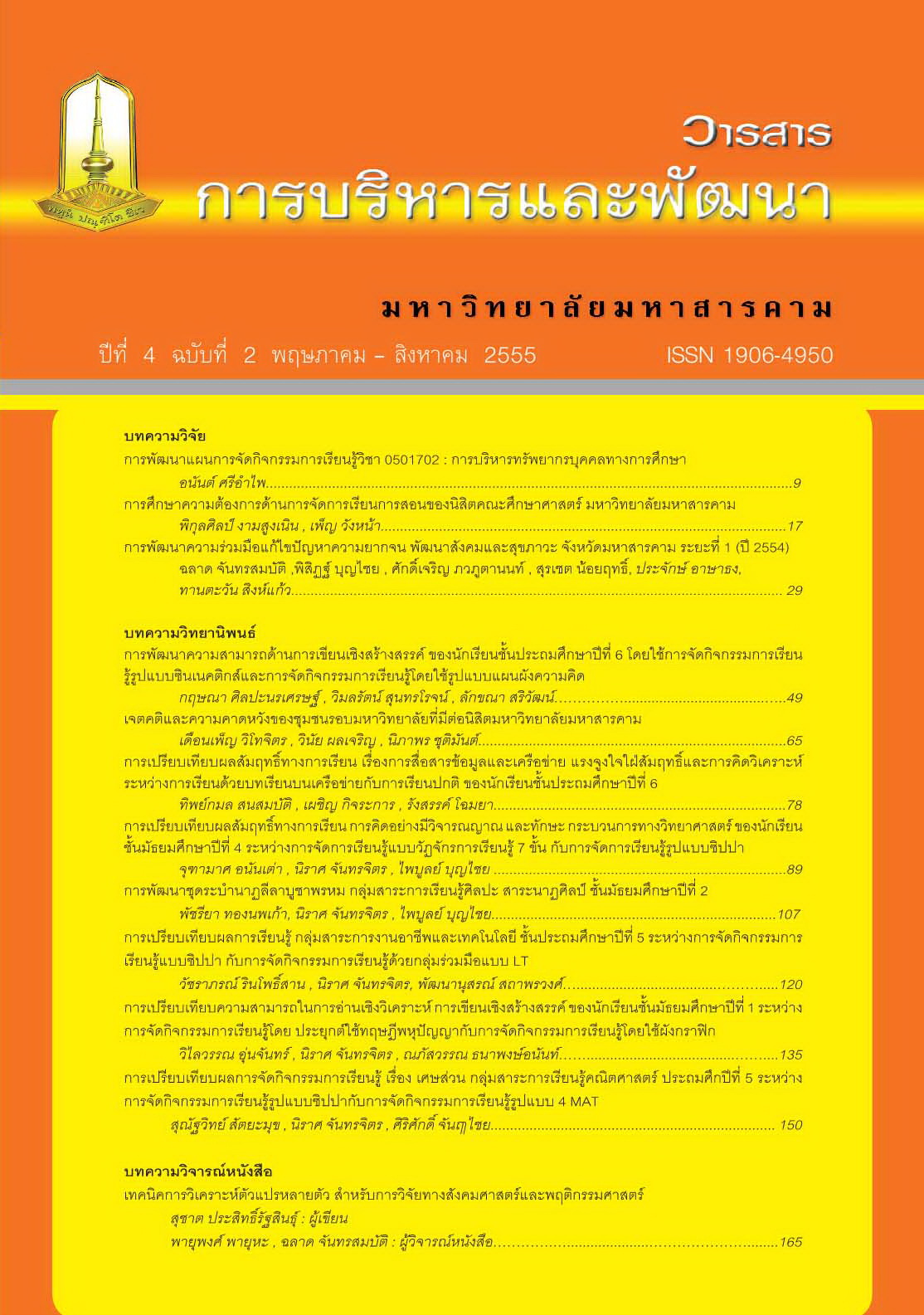การเปรียบเทียบผลการเรียนรู้ กลุ่มสาระการงานอาชีพและเทคโนโลยี ชั้นประถมศึกษาปีที่ 5 ระหว่างการจัดกิจกรรมการเรียนรู้แบบซิปปา กับการจัดกิจกรรมการเรียนรู้ด้วยกลุ่มร่วมมือแบบ LT
Main Article Content
Abstract
บทคัดย่อ
การวิจัยครั้งนี้มีความมุ่งหมายเพื่อ (1) พัฒนาแผนการจัดกิจกรรมการเรียนรู้แบบซิปปาและแผนการจัดกิจกรรมการเรียนรู้ด้วยกลุ่มร่วมมือแบบ LT เรื่อง เทคโนโลยีสารสนเทศ กลุ่มสาระการงานอาชีพและเทคโนโลยี ชั้นประถมศึกษาปีที่ 5 ที่มีประสิทธิภาพตามเกณฑ์ 80/80 (2) หาดัชนีประสิทธิผลของแผนการจัดกิจกรรมการเรียนรู้แบบซิปปา และแผนการจัดกิจกรรมการเรียนรู้ด้วยกลุ่มร่วมมือแบบ LT เรื่อง เทคโนโลยีสารสนเทศ (3) เปรียบเทียบผลสัมฤทธิ์ทางการเรียน และความสามารถในการคิดวิเคราะห์ของนักเรียนชั้นประถมศึกษาปีที่ 5 ระหว่างการจัดกิจกรรมการเรียนรู้แบบซิปปากับการจัดกิจกรรมการเรียนรู้ด้วยกลุ่มร่วมมือแบบ LT และ (4) ศึกษาความพึงพอใจในการเรียนของนักเรียนชั้นประถมศึกษาปีที่ 5 ที่มีต่อการจัดกิจกรรมการเรียนรู้ทั้งสองรูปแบบ กลุ่มตัวอย่าง ได้แก่ นักเรียนชั้นประถมศึกษาปีที่ 5 ห้อง 5/1 และ 5/2 โรงเรียนอนุบาลวิศิษฐ์ อำนวยศิลป์ อำเภอบึงกาฬ สำนักงานเขตพื้นที่การศึกษาหนองคาย เขต 3 ภาคเรียนที่ 1 ปีการศึกษา 2552 จำนวน 2 ห้อง ๆ ละ 30 คน ซึ่งได้มาโดยการสุ่มแบบกลุ่ม (Cluster Random Sampling) และจับสลากได้นักเรียนชั้นประถมศึกษาปีที่ 5/1 และ5/2 เป็นกลุ่มทดลองจัดกิจกรรมการเรียนรู้แบบซิปปา และจัดกิจกรรมการเรียนรู้ด้วยกลุ่มร่วมมือแบบ LT ตามลำดับ เครื่องมือที่ใซ้ในการวิจัย ได้แก่ (1) แผนการจัดกิจกรรมการเรียนรู้แบบซิปปาและแผนการจัดกิจกรรมการเรียนรู้ด้วยกลุ่มร่วมมือแบบ LT จำนวนรูปแบบละ 8 แผนรวมเวลา 16ชั่วโมง(2) แบบทดสอบวัดผลสัมฤทธิ์ทางการเรียนชนิดปรนัยเลือกตอบ 4 ตัวเลือก จำนวน 30 ข้อ (3) แบบทดสอบวัดความสามารถการคิดวิเคราะห์ชนิดปรนัยเลือกตอบ 4 ตัวเลือก จำนวน 25 ข้อ และ (4) แบบวัดความพึงพอใจในการเรียน เป็นแบบมาตราส่วนประมาณค่า 5 ระดับ จำนวน 20 ข้อ และทดสอบสมมุติฐานใช้ Independent Samples t-test
ผลการวิจัยปรากฏ ดังนี้
1. แผนการจัดกิจกรรมการเรียนรู้แบบซิปปา และแผนการจัดกิจกรรมการเรียนรู้ด้วยกลุ่มร่วมมือแบบ LT เรื่อง เทคโนโลยีสารสนเทศ ชั้นประถมศึกษาปีที่ 5 มีประสิทธิภาพเท่ากับ 85.71/82.78 และ 84.81/81.44 ตามลำดับ
2. แผนการจัดกิจกรรมการเรียนรู้แบบซิปปา และแผนการจัดกิจกรรมการเรียนรู้ด้วยกลุ่มร่วมมือแบบ LT เรื่องเทคโนโลยีสารสนเทศชั้ นประถมศึกษาปีที่ 5 มีค่าดัชนีประสิทธิผลเท่ากับ 0.7212 และ 0.6693 แสดงว่านักเรียนมีความก้าวหน้าทางการเรียนคิดเป็นร้อยละ 72.12 และ 66.93 ตามลำดับ
3. นักเรียนชั้นประถมศึกษาปีที่ 5 กลุ่มที่ได้รับการจัดกิจกรรมการเรียนรู้แบบซิปปา และกลุ่มที่ได้รับการจัดกิจกรรมการเรียนรู้ด้วยกลุ่มร่วมมือแบบ LT มีผลสัมฤทธิ์ทางการเรียนและความสามารถในการคิดวิเคราะห์หลังเรียนไม่แตกต่างกัน
4. นักเรียนกลุ่มที่ได้รับการจัดกิจกรรมการเรียนรู้แบบซิปปา และกลุ่มที่ได้รับการจัดกิจกรรมการเรียนรู้ด้วยกลุ่มร่วมมือแบบ LT มีความพึงพอใจต่อการเรียนโดยรวมอยู่ในระดับมากที่สุด และระดับมากตามลำดับ
คำสำคัญ : การจัดกิจกรรมการเรียนรู้แบบซิปปา, การจัดกิจกรรมการเรียนรู้ด้วยกลุ่มร่วมมือแบบ LT, ผลสัมฤทธิ์ทางการเรียน, ความสามารถในการคิดวิเคราะห์, ความพึงพอใจต่อการเรียน
ABSTRACT
The purposes of this study were (1) to find out efficiencies and an effectiveness indices of the plans for organization of CIPPA model and cooperative learning with LT technique entitled information technology in career working and technology strands ; (2) to compare learning achievement, and analytical thinking of Prathomsueksa 5 students between using both of learning approaches; (3) to find out the students’ satisfaction toward learning of CIPPA model and LT technique cooperative learning. The sample used in this study consisted of 60 Prathomsueksa 5 students attending Amnuaywisit Kindergarten school in Buengkarn district, Nhongkai Province in the first semester of the academic year 2009, obtained using the cluster random sampling technique. They were divided into two experimental groups by assigned group of 30 students from Amnuaywisit Kindergarten school and random assignment the students group of 5/1 for CIPPA learning model and group of 5/2 for LT technique cooperative learning. Two types of the instruments used for the study were the instrument use a for the experiment comprised 2 types of plans for organization of learning : plans for organization of CIPPA model and LT technique cooperative learning, 8 plans each, for 2 hours per plan ; and 2 types of the instruments used for collecting data comprised of a 30-item achievement test; a 20-item of analytical thinking test; and a 20-item scale on satisfaction in each of learning organization . The statistics used for analyzing data were percentage, mean, standard deviation, and t-test (independent samples).
The results of the study were as follows :
1. The plans for organization of CIPPA model and LT technique cooperative learning entitled information technology had efficiencies (E1/E2) of 85.71/82.78 and 84.81/81.44 respectively.
2. The plans for organization of CIPPA model and LT technique cooperative learning had the effectiveness indexes of 0.7212 and 0.6693; indicating that these students progressed their learning at 72.12 and 66.93 percent respectively.
3. The students who learned using the method of organization of CIPPA model and LT technique cooperative learning had not show different learning achievement and analytical thinking.
4. The students who learned using learning organization of CIPPA model and LT technique cooperative learning had satisfaction with both of learning approaches at the highest and a high levels respectively.
Keywords: Organization of CIPPA model, Cooperative learning with LT technique, Learning achievement, Analytical thinking ability, Satisfaction toward learning

